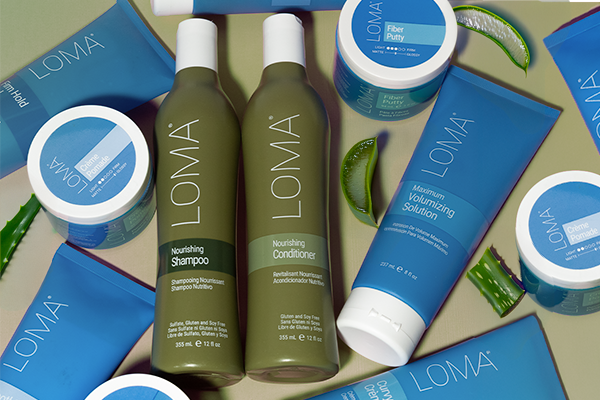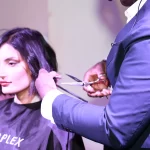LOMA has long stood out in the professional haircare world—not only for its clean, luxurious formulations but also for its integrity-driven approach to manufacturing, sustainability, and salon education. At the helm is David Hanen, a former stylist turned chemist and founder, whose deep industry insight and passion for elevating both products and people have shaped LOMA into the globally respected brand it is today. We sat down with David at Cosmoprof Bologna 2025 to hear the story behind the brand in his own words.
 You pioneered organic aloe vera gel use in professional haircare over three decades ago. What sparked that innovation?
You pioneered organic aloe vera gel use in professional haircare over three decades ago. What sparked that innovation?
Thirty-five years ago, I was struggling with raw hands from harsh, salt-based shampoos. I didn’t just want to make something better—I needed to. With the guidance of my mentor in Canada, we began formulating with organic aloe vera gel. It was revolutionary at the time. No one was thinking about putting high-quality, healing ingredients into salon shampoos. But aloe had this incredible balance of hydration and nourishment. Now, it’s everywhere. I’m proud to say we helped lead that movement.
LOMA manufactures 95% of its products in-house. Why was it important to you to control your own production?
When I first started, I worked with a private label lab and was excited to launch my own product—until I opened the conditioner, and it smelled like fish oil. That was the day I said, “Never again.” We started manufacturing ourselves to control every aspect—from the source of our raw materials to the purity of our water. I know exactly what goes into every bottle, and I know it performs. If it doesn’t, no amount of branding will save it. That’s the difference between us and most professional brands—they’re marketers. We’re makers.
What are some specific sustainability practices LOMA upholds in its production process?
First, our number one ingredient is organic aloe vera gel, which we reconstitute using the cleanest water in North America. Our facility near Seattle draws from an aquifer surrounded by evergreens, and our water measures just 0 to 3 parts per million after filtration—that’s unheard of. We also avoid ingredients like salt, which is cheap but damaging, and we’ve been sulfate-free for 35 years. Beyond that, our entire ethos is built around quality over quantity—no fluff, no shortcuts.
You’re present in 23 countries now. How do you tailor your brand’s message and product strategy to such diverse markets?
We take a collaborative approach. When we enter a new country, we sit down with our distributors and go over a core list—15 points that define what LOMA is. From there, we help them localise the language and emphasis. Maybe one country focuses more on aloe, another on affordability, another on clean fragrance. But the message is always honest. We train their educators, provide visual assets, and stay close to how the brand is being represented. It’s all about respecting the uniqueness of each market while staying true to our values.
You built your career behind the chair. How has your experience as a stylist influenced the way you now train the new generation of hairdressers?
Early in my career, I was focused on booking as many appointments as possible—9:00, 9:30, 10:00. But then a mentor shifted my mindset completely. I’ll never forget it: The day I stopped doing hair for money was the day I started making money doing hair. That changed everything. I began focusing on the person in the chair, not the paycheck. I studied how people communicate—whether they’re visual, auditory, or kinesthetic—and that transformed how I spoke to and connected with clients. Now, I bring that into every course I teach. We train stylists not just in technique but in emotional intelligence, in building trust, and in creating experiences. Because if you can do that, you’ll never have an empty chair.
The salon industry has seen seismic shifts in recent years. How has LOMA adapted to support professionals?
When I started in the ’80s, 80% of salon clients bought their products in-salon. Today, it’s maybe 5%. That’s heartbreaking. So, I teach stylists how to reconnect with clients—how to speak their language, build trust, and offer value they can’t get online. We focus a lot on education, not just on the product but on communication, client retention, and business building. Hairdressers are natural influencers. They just need the tools and confidence to own that role again.
What advice would you give stylists today—about their craft, client relationships, and selling in the salon?
First, stop thinking like a service provider and start thinking like a trusted advisor. You have a captive audience in your chair for 45 minutes to three hours. That’s gold. Use that time to build a relationship, educate them, and show them something they can’t get from Amazon. Don’t sell—share. “This product will help your style last longer.” “This conditioner will protect your colour.” That’s not upselling; that’s solving a problem. And don’t give up on retail just because the game has changed. Adapt. Be the expert. Be the reason they come back.
What’s next for LOMA and the natural haircare space more broadly?
People are becoming more ingredient-savvy, but they’re also overwhelmed by greenwashing. I think the next wave is brutal honesty—about what ingredients do, where they come from, and why they’re used. We’re already there. I’m also excited about expanding our “Simple Science” series to demystify cosmetic chemistry. At LOMA, we’ll keep doing what we’ve always done: make clean, effective products with intention and support the professionals who use them. Trends come and go. Integrity doesn’t.












